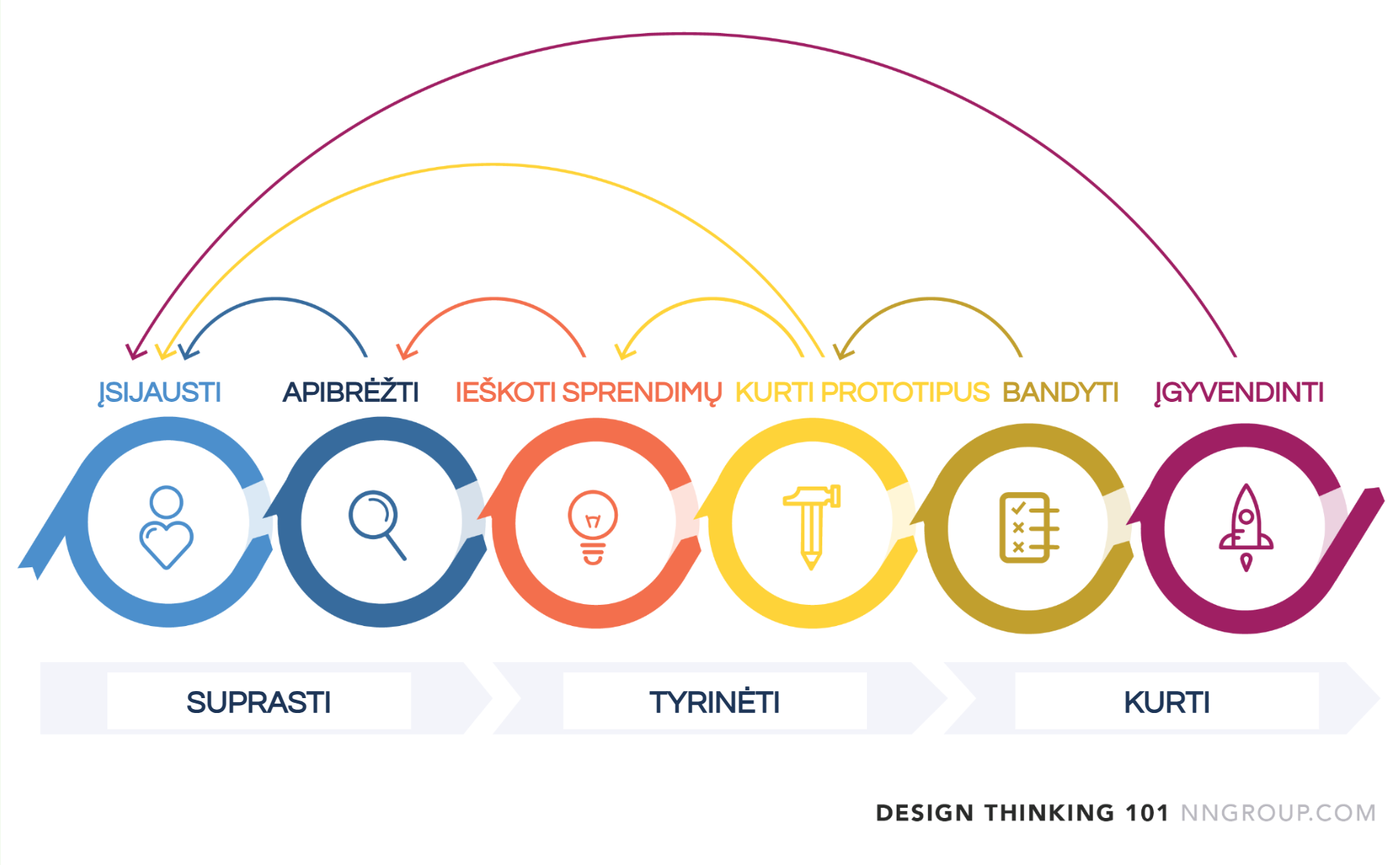7
'LearnINN' – inovacijų kūrimas darbe su jaunimu
'LearnINN' – inovacijų kūrimas darbe su jaunimu
Apie
Šis mokymosi grojaraštis veda jus per pagrindinius dizaino mąstymo proceso etapus:
Įsijautimas → Apibrėžimas → Idėjų generavimas → Prototipų kūrimas → Testavimas.
Jis pateikiamas darbo su jaunimu ir inovacijų kontekste. Eidami per veiklas, tyrinėsite, kaip į žmogų orientuotas dizaino mąstymas, skaitmeniniai įrankiai ir kūrybinis bendradarbiavimas gali padėti spręsti realius iššūkius jūsų darbe.
Baigę šį grojaraštį ir surinkę bent 4 teminius ženkliukus, gausite galutinį pripažinimo ženkliuką už aktyvų mokymąsi apie inovacijų plėtrą darbo su jaunimu srityje. Šį ženkliuką galėsite sugeneruoti ir sertifikato pavidalu bei jį rasto savo kontrolinės panelės skiltyje 'Sertifikatai'
Bendras mokymosi laikas yra 30 valandų, sudarytų iš individualaus ir grupinio mokymosi tiek gyvai, tiek internetu.
Mokymasis ir atvirieji ženkliukai, gaunami šiame mokymosi grojaraštyje, yra suderinti su ETS kompetencijų modeliu jaunimo darbuotojams, taip pat su EntreComp kompetencijų modeliu bei ESCO duomenų baze.
Šis mokymosi grojaraštis yra KA2 bendradarbiavimo partnerystės projekto Learn INN, kurį remia Europos Sąjungos Erasmus+ programa, dalis.

Baigti renginius
Atlikite šias veiklas, gaukite ženkliukus ir pamatysite grojaraščio progresą
Apie
Į žmogų orientuotas dizaino mąstymas yra kūrybiškas ir bendradarbiavimu grįstas problemų sprendimo metodas, kuris prasideda nuo žmonių. Jis skatina mus giliai suprasti tų, su kuriais dirbame – šiuo atveju, jaunų žmonių – poreikius, lūkesčius ir iššūkius.
Užuot iš karto einant prie sprendimų, šis metodas kviečia klausti, klausytis, empatiškai įsijausti ir kartu kurti idėjas, kurios iš tiesų yra prasmingos. Jis apima penkis pagrindinius etapus: įsijausti, apibrėžti, generuoti idėjas, kurti prototipus ir išbandyti. Vis dėlto jie ne visada vyksta griežta tvarka. Priklausomai nuo dizaino mokyklos, šie etapai gali būti vadinami skirtingai, o kai kuriais atvejais jų gali būti ir daugiau.

Pavyzdžiui, IDEO agentūra, garsėjanti savo į žmogų orientuoto dizaino darbais, pristato detalesnius žingsnius toje pačioje eigoje: suformuluoti klausimą – rinkti įkvėpimą – apibendrinti įžvalgas – generuoti idėjas – paversti idėjas apčiuopiamomis – testuoti, kad išmoktum – pasidalinti istorija.

Darbas su jaunimu ir neformalusis ugdymas, orientuotas į žmogų, suteikia galimybę:
- Įtraukti jaunus žmones kaip partnerius, o ne tik dalyvius.
- Kurti programas, įrankius ir sprendimus, atliepiančius realius poreikius.
- Ugdyti kūrybinį pasitikėjimą savimi ir bendradarbiavimo dvasią procese.
Šioje veikloje nagrinėsi įsijautimo (Empathise) etapą – vieną iš kertinių į žmogų orientuoto mąstymo elementų, kuris padeda atrasti įžvalgas klausantis ir stebint.
1. Skaityk daugiau apie konkrečius į žmogų orientuoto dizaino mąstymo aspektus, sutelkiant dėmesį į įsijautimo (Empathise) ir apibrėžimo (Define) etapus.
2. Žiūrėk: „Design Thinking Process“ – paprastas animuotas paaiškinamasis vaizdo įrašas.
3. Pasidalink savo įžvalgomis
Įkelkite vieną įžvalgą arba netikėtą atradimą iš savo empatijos žemėlapio.
Apie tai pagalvokite: kaip tai pakeitė jūsų supratimą apie iššūkį? Kaip ši įžvalga galėtų paveikti sprendimą, orientuotą į jaunus žmones?
Medžiaga
Gauk veiklos ženkliuką
Į žmogų orientuoto dizaino mąstytojas Gauk šį ženkliuką
Aš gavau šį ženkliuką, tyrinėdamas į žmogų orientuoto dizaino mąstymo metodą ir praktikuodamas empatijos žemėlapių sudarymą, kad geriau suprasčiau kitų poreikius ir patirtis. Įsitraukiau į prasmingus pokalbius, atidžiai klausiausi ir prisidėjau prie bendro realių iššūkių, su kuriais susiduria jaunimo darbuotojai, supratimo kūrimo. Ši patirtis sustiprino mano gebėjimą siekti inovacijų su empatija, smalsumu ir refleksija.
Šis ženkliukas yra KA2 bendradarbiavimo partnerystės projekto Learn INN, kurį remia Europos Sąjungos Erasmus+ programa, dalis.
Užduotys
Užduotis nr.1
Įrodymus patikrino: vienas renginio organizatorius
Pasidalykite viena įžvalga ar momentu iš savo „empatijos“ etapo darbo, kuris padėjo geriau suprasti tikrą poreikį ar iššūkį jūsų organizacijoje.
(Galite parašyti savo atsakymą arba įkelti paveikslėlį su trumpu komentaru.)
Įgūdžiai
ESCO
#innovate
ETS-TR
#Choose and designing appropriate methods for collecting, interpreting and disseminating information (data, resources, findings, etc.)
ETS-TR
#Where applicable, includes the community’s needs in the programme design
ESCO
#demonstrate empathy
#Siekti užsibrėžtų edukacinių tikslų pasitelkiant konkrečius būdus ir metodus, kurie skatina kūrybiškumą ir problemų sprendimą
ETS-TR
#Facilitates problem solving
#Siekti užsibrėžtų edukacinių tikslų pasitelkiant konkrečius būdus ir metodus, kurie skatina kūrybiškumą ir problemų sprendimą
ETS-TR
#Enables participants to be creative and think out of the box
ESCO
#brainstorming ideas
#Atvirumas naudoti skirtingus būdus ir metodus, skatinančius kūrybišką mąstymą bei problemų sprendimą
ETS-TR
#Understands the impact of Artificial Intelligence on choosing learning objectives when using online platforms for learning
ESCO
#innovate
ESCO
#build craft prototypes
#Siekti užsibrėžtų edukacinių tikslų pasitelkiant konkrečius būdus ir metodus, kurie skatina kūrybiškumą ir problemų sprendimą
Renginiai: 5
Pradėta: 23
Pabaigė grojaraštį: 23
Laikas pabaigti: 13 valandų 30 minučių
Dalintis:
Organizatoriai
Awero
Badge issuer recognized with
Awero palaiko šią platformą ir plėtoja ją kartu su pagrindinėmis švietimo organizacijomis. Europos Sąjungos programa Erasmus+ dalinai finansavo pirmosios platformos versijos sukūrimą. Susisiekite su mumis support@Awero.org.
Platforma
Pakeisti į kitą kalbą:

